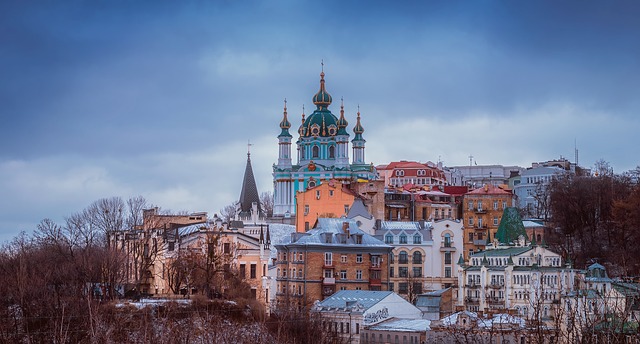By Tim Lambert
The Early History of Ukraine
In the 7th century BC, a people called the Scythians lived in what is now Ukraine. Later the Greeks settled on the north coast of the Black Sea and they founded city-states there. Slavs settled in Ukraine in the 5th and 6th centuries AD.
Then in the 9th century, Swedish Vikings sailed along rivers into the heart of Eastern Europe. Some of them settled in Ukraine. In 882 a Viking named Oleg captured Kyiv and it became the capital of a powerful state. In 988 under Vladimir I Ukraine converted to Christianity.
However, in the 11th and 12th centuries, the state broke up into fragments. Disaster struck in 1240 when the Mongols, led by Batu, grandson of Genghis Khan conquered southern and eastern Ukraine. However northern and western Ukraine remained independent until the 14th century when it was taken over by the Poles and Lithuanians. They gradually drove back the Mongols or Tartars. However, the Tartars still held Crimea and in the 15th century, they came under the domination of the Turkish Empire.
In the 15th and 16th centuries, some serfs (halfway between slaves and freemen) ran away from Polish landlords and settled on the steppes of Ukraine. They were called Kozaky (Cossacks), which means freemen. The Cossacks formed self-governing communities. Eventually, they united to form the Cossack Hetmanate led by a hetman (general).
In the late 17th century, Poland came to dominate western Ukraine while Russia dominated eastern Ukraine. Then in the 18th century Catherine the Great, Empress of Russia was determined to absorb eastern Ukraine into the Russian Empire. The Cossack Hetmanate was abolished in 1764.
Meanwhile, in the 18th century, Poland was declining and in 1772-1795 Russia and Austria decided to help themselves to Polish territory. Most of western Ukraine was taken by Russia (except for a small strip in the far west, which went to Austria). Finally, in 1783 Russia conquered Crimea. Catherine the Great also founded Odessa.
20th Century Ukraine
In the 19th century, Ukraine was ruled by Russia. But from the mid-19th century, nationalism spread. In 1918 while Russia was engaged in civil war Ukraine became independent. However, in 1921 the Russians forced Ukraine to become part of the Soviet Union (successor to the Russian Empire).
Stalin decided that farms in Ukraine should be collectivized. In other words, peasants would be deprived of their land and livestock and made to work as farm laborers on land now owned by the state. However, collectivisation met with resistance.
Stalin was determined to crush the Ukrainian peasants, and he caused a terrible famine in 1932-33 that took the lives of millions of innocent people. In 1932, collective farms were given completely unrealistic quotas to fill. Soviet law decreed that the peasants would not be allowed to keep any grain until they had met their quotas. They could not, of course, meet them, so Soviet officials confiscated all the grain they wanted, leaving the peasants to starve. How many people died in this man-made famine is not known for sure, but it was undoubtedly several million. This horrific man-made famine is known as the Holodomor. Many countries have recognised the Holodomor as a genocide.
However, Ukraine’s suffering was not over. During 1937-39 Stalin unleashed purges in which many Ukrainians were executed or sent to prison camps. Then in 1941, the Germans invaded the Soviet Union. They murdered millions of Ukrainians. However, by 1943, the Germans were losing the war and the Soviet Army recaptured Kyiv on 6 November 1943. Afterward, Stalin took reprisals against anyone he suspected of being disloyal or of collaborating with the Germans. All the Crimean Tatars were deported.
In 1986 there was a disaster at the nuclear power plant at Chornobyl. The authorities tried to cover up the disaster and it caused much resentment. In the late 1980s, Ukrainians became increasingly dissatisfied with rule from Moscow and in 1989 the RUKH (Ukrainian People’s Movement for Restructuring) was formed and in 1990 demonstrations were held.
With the collapse of Communism and the breakup of the Soviet Union in 1991, Ukraine once more became independent. However, the transition from Socialism to Capitalism was a painful one. Ukraine suffered high inflation and economic decline for some years. However, economic growth eventually began again.
21st Century Ukraine
The transition from dictatorship to democracy also did not go smoothly. In late 2004 Viktor Yanukovych won a presidential election. However, many people believed the election was rigged and supporters of the other candidate Viktor Yushchenko held demonstrations for 10 days. Eventually, a rerun was held and Yushchenko was elected. He became president early in 2005. This was called the Orange Revolution.
Ukraine suffered badly in the economic downturn of 2008-2009. But that was temporary and Ukraine recovered.
In 2013 and 2014 a wave of demonstrations swept across Ukraine when President Yanukovych rejected an association treaty with the EU. In February 2014 the Ukrainian parliament voted to remove Yanukovych from power. After the new elections, Petro Poroshenko became president of Ukraine.

In 2014 Russia illegally annexed Crimea.
In 2022 the population of Ukraine was 44 million.
On 24 February 2022, Russia invaded Ukraine. At present, the Ukrainian people are courageously resisting.
Last revised 2024